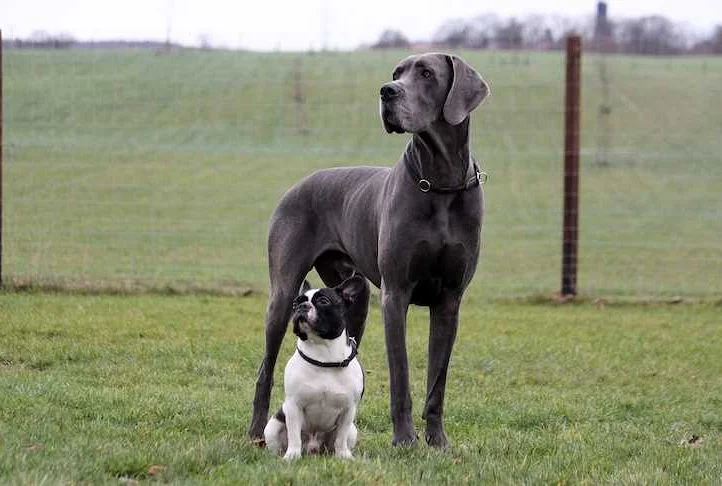Choosing a Dog: Who Will Live with You Longer – a Large or Small Breed?
Содержимое
Discover the pros and cons of choosing a large or small breed dog and how their size can impact their lifespan. Learn about the factors that can affect a dog’s longevity and make an informed decision about the best fit for your family.
When it comes to choosing a furry companion, one important factor that many pet owners consider is the lifespan of the breed. It’s only natural to want a dog that will be a part of your life for as long as possible, providing love, companionship, and joy. However, the question remains: will a large or small breed live longer?
The answer is not as straightforward as one might think. While it is true that smaller dogs tend to have longer lifespans when compared to larger breeds, there are many factors that come into play. Genetics, diet, exercise, and overall healthcare all contribute to a dog’s lifespan.
Genetics play a crucial role in determining how long a dog will live. Smaller breeds, such as Chihuahuas or Dachshunds, often live well into their late teens or even early twenties. On the other hand, larger breeds, like Great Danes or Saint Bernards, tend to have shorter lifespans, typically living between 6 and 10 years.
However, it’s important to note that genetics is not the only determining factor. Diet also plays a significant role in a dog’s lifespan. Providing your dog with a balanced and nutritious diet can help to ensure that they live a long and healthy life. It is essential to feed your dog a diet that is appropriate for their age, size, and activity level.
Pros and Cons of Large Dog Breeds

Large dog breeds have their own unique advantages and disadvantages. Whether you’re considering getting a large dog or already own one, it’s important to be aware of these factors:
Pros:
1. Protection: Large dog breeds can provide a sense of security and protection for you and your family. Their size and strength can be a deterrent to potential intruders.
2. Exercise Companions: If you enjoy outdoor activities and exercise, a large dog breed may be a great companion. They have the stamina and energy to keep up with your active lifestyle.
3. Guard Dogs: Many large dog breeds are known for their protective instincts. They can be trained to guard your property and act as excellent watchdogs.
4. Family Pets: Large dog breeds can be great additions to families with children. They often have a gentle and friendly nature, and can be patient and tolerant with kids.
Cons:
1. Space Requirements: Large dog breeds need ample space to move around and exercise. They may not be suitable for small apartments or homes without a backyard.
2. Cost: Large dogs generally require more food, grooming supplies, and healthcare than smaller breeds. This can result in higher expenses over their lifespan.
3. Lifespan: On average, large dog breeds tend to have shorter lifespans compared to smaller breeds. This means that you may have a shorter time to spend with your beloved pet.
4. Training and Socialization: Large dog breeds may require more training and socialization to ensure they grow up to be well-behaved and obedient. They can be strong-willed and may need consistent training from an early age.
When considering a large dog breed, it’s important to weigh these pros and cons and decide if it’s the right fit for your lifestyle and preferences. Proper care, training, and socialization are key to raising a well-adjusted and happy large dog.
Factors Affecting Lifespan

Several factors can influence the lifespan of both large and small dog breeds. While genetics play a significant role, other factors also contribute to the overall life expectancy of a dog.
Diet: Proper nutrition is crucial for maintaining good health and longevity in dogs. Feeding a balanced diet that meets their nutritional needs can help prevent certain diseases and conditions that may shorten their lifespan.
Exercise: Regular exercise is essential for keeping dogs physically and mentally stimulated. It helps prevent obesity, strengthens their immune system, and improves their overall well-being, which can contribute to a longer lifespan.
Weight: Maintaining a healthy weight is vital for dogs as excess weight can lead to various health issues, including heart disease, diabetes, and joint problems. Obesity can significantly reduce a dog’s lifespan, so it is important to monitor their weight and provide appropriate portion sizes.
Medical Care: Regular veterinary check-ups and preventive care are crucial for detecting and treating any health problems early on. Vaccinations, parasite control, dental care, and routine bloodwork are essential to ensure a long and healthy life for dogs.
Environment: A dog’s living environment can impact their lifespan. Dogs that are exposed to environmental toxins, extreme temperatures, or stressful conditions may have a shorter lifespan compared to those in a safe and comfortable environment.
Breed-Specific Factors: Each breed has its own set of health issues and genetic predispositions that can affect their lifespan. Some breeds are prone to certain diseases, while others may have fewer health concerns. Understanding these breed-specific factors can help dog owners make informed decisions about their pet’s care.
Overall Care and Attention: The love, care, and attention a dog receives from its owner can have a significant impact on their lifespan. Dogs that are well-loved, properly trained, and socialized tend to live longer and healthier lives.
While breed size may have some influence on a dog’s lifespan, it is important to remember that many factors can affect their overall longevity. By focusing on these various factors, dog owners can help ensure that their furry friends live happy and healthy lives for as long as possible.
Health Concerns and Longevity
When considering the lifespan of a dog, it’s important to take into account any health concerns that may arise. Both large and small breeds can be prone to certain health conditions that can affect their longevity.
Large breeds are more likely to experience joint and bone problems, such as hip dysplasia and arthritis. These issues can lead to reduced mobility and discomfort for the dog, ultimately affecting their quality of life. Additionally, larger dogs may be more prone to certain types of cancer.
On the other hand, small breeds are often more susceptible to dental problems, such as tooth decay and gum disease. They may also have a higher risk of developing heart conditions, such as mitral valve disease. These health issues can impact the overall well-being and lifespan of a small breed dog.
In general, providing proper care, nutrition, and regular veterinary check-ups can help mitigate some of these health concerns. Regular exercise and maintaining a healthy weight can also contribute to a longer lifespan for dogs of all sizes.
It’s important to note that individual dogs within each breed can vary in terms of their health and lifespan. While certain health conditions may be more common in specific breeds, it’s not a guarantee that every dog of that breed will experience them.
Ultimately, it is essential to be aware of potential health concerns associated with different breeds and to choose a dog that fits your lifestyle and commitment to providing necessary care.
Nutritional Requirements
Proper nutrition plays a crucial role in the overall health and longevity of dogs, regardless of their size. However, the nutritional needs of large and small breeds differ to some extent.
Large breed dogs require a balanced diet that supports their growth and development while preventing issues such as joint problems and obesity. Their diet should be rich in high-quality protein, which helps in muscle development. Additionally, they need controlled amounts of calcium and phosphorus to support healthy bone growth.
Small breed dogs, on the other hand, have faster metabolisms and may need more calories per pound of body weight compared to larger breeds. Their diet should be formulated to meet their higher energy needs. Small breeds also have smaller mouths and teeth, so their kibble size should be appropriate for easy chewing and digestion.
Regardless of size, dogs require certain essential nutrients, including vitamins, minerals, and fats. These nutrients are necessary for a strong immune system, healthy skin and coat, and overall vitality. However, the specific amounts and ratios of these nutrients may vary based on the size of the dog.
It is essential to consult with a veterinarian or a professional animal nutritionist to determine the specific nutritional requirements of your dog, taking into account their breed, age, weight, and activity level. They can help formulate a diet plan that meets your dog’s specific needs and promotes their long-term health and well-being.
| Rich in high-quality protein for muscle development | Formulated to meet higher energy needs |
| Controlled amounts of calcium and phosphorus for healthy bone growth | Appropriate kibble size for easy chewing and digestion |
| Essential nutrients for a strong immune system and overall vitality |
Exercise and Activity Levels
When choosing a dog, it’s important to consider their exercise and activity levels. Different breeds have different energy levels and exercise requirements, so it’s essential to find a dog that matches your lifestyle and activity level.
Large breeds, such as Golden Retrievers and Labradors, typically require more exercise compared to small breeds. They have higher energy levels and need more physical activity to stay healthy and satisfied. Daily walks and playtime are necessary to keep them mentally and physically stimulated.
Small breeds, like Chihuahuas and Pomeranians, have lower exercise needs. They are more suitable for apartment living or for people with limited mobility. Short walks and indoor play sessions are usually sufficient to meet their exercise requirements.
It’s important to note that even though small breeds require less exercise, they still need mental stimulation. Interactive toys, puzzle games, and training sessions can help keep them engaged and prevent boredom-related behavior problems.
Regular exercise and activity are not only essential for your dog’s physical health but also for their mental well-being. Dogs that don’t get enough exercise can become restless, anxious, and develop behavioral issues. On the other hand, dogs that get regular exercise are more likely to have a longer lifespan and overall better health.
To ensure your dog gets enough exercise, it’s crucial to make time for daily walks, playtime, and mental stimulation. Consider your own energy level and availability for exercise when choosing a dog breed, as it can significantly impact both your and the dog’s quality of life.
| Higher exercise needs | Lower exercise needs |
| Require daily walks and playtime | Short walks and indoor play sessions are usually enough |
| Need mental and physical stimulation | Require mental stimulation |